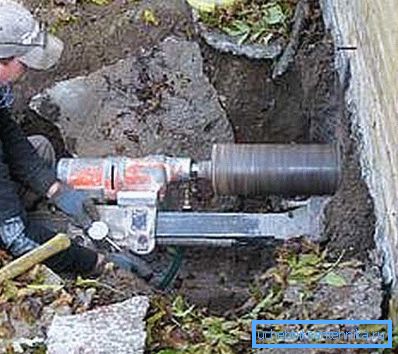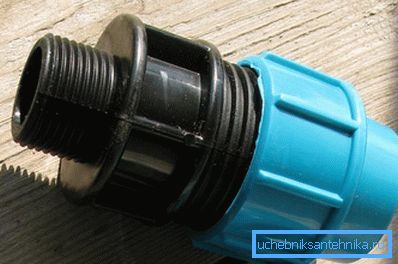Plumbing: professional recommendations
It is very good, when input of a water supply system to the house without a basement is provided when pouring or assembling the foundation. That is, a special opening is provided for its installation. It is much more difficult to make such an installation already in the finished building, when it is necessary not only to dig the ground, but also to make a hole in the concrete or stone layer.
However, both options are possible. We will consider the main indicators that should guide the installation, methods of installation, as well as show you the video in this article.

Water in the house
Some input features

- The level of soil freezing in different regions is very different, so it can be 30-40 cm, but it can be more than one and a half meters, so before you run the water supply or sewage system, you need to know these parameters for your area. The fact is that the depth of installation and the entry of the pipe into the building according to SNiPU-G.3-62 should be carried out 50 cm below this critical glasses. However, the same applies to the installation of a deeper foundation, especially if the house is on heaving (unstable) soils.
- In some cases, if the building is built, and communications are not carried out, they are led into the house under the foundation, but this is sometimes quite difficult, especially if the bottom of the base is below one and a half meters from the ground surface.. Therefore, it is usually considered an option that involves the passage of the pipeline through a concrete or stone tape (it can be cast or prefab) and for this, too, a lot of effort is needed.
- In addition, water input into the house from the water supply system or the well (from the pump) is associated with some difficulties - the floors in the room are always above the ground level (usually they are laid in line with the base) and you will have to dig a hole from the inside. So if a concrete screed is poured inside, you will have to overcome two serious obstacles - the foundation tape and the concrete floor.
- When laying water pipes into a building without a basement, you still have to warm them, regardless of the depth of the trench - this is necessary in case of emergency situations, for example, wet ground and a sharp cooling.
Installation
Note. Below we will look at how to make the input through the concrete strip (monolithic) foundation, where we will need to make a hole.

All installation work on laying and entering the water supply system into the building begins with digging a trench, which should be at least 50 cm deeper than the level of soil freezing.
If you want to fully adhere to SNiP P-G.3-62, then you will have to go deeper by 4-5 cm, because the pipe is not laid directly on the ground - for this you need a sand cushion at least 3-4 cm thick. But if sewage is laid alongside the water supply, then it should be taken into account that these same half meters are counted not from the base, but from the surface of the pipe.
Digging the trench should be coordinated with the place where the pumping station will be located in the house, and if it is in another room, then with the place where you are going to make the water distribution unit and the pit for entering.
And after the trench from the well or the public water line has been dug up to the house, you will need to make a water supply pit to make it possible to punch a hole in the foundation. In other words, it should be a place where one person can turn around with a puncher and a shovel.

If the foundation was laid without a reinforcement cage, and this is possible in precast tapes, then diamond drilling can be used for drilling holes, that is, a special electric drill with a diamond cutter can be used for this, which can be managed in half an hour.
Drilling of a flood of concrete tape is impossible at all - such a foundation is poured on the basis of the reinforcement cage, therefore, it cannot be passed through any diamond. Nor pobeditovoy cutter. For this you need a good punch with long drills and a chisel, where the minimum impact force is 4-5 joules and higher.
So, let's imagine a conditional situation where a trench with a pit is dug out and from the side of the room, too, everything is ready - all that remains is to punch a hole in the wall. To do this, we will have to draw a hole into which a 50-millimeter pipe can be inserted (provided that the water supply system will be supplied with a 32-mm polyethylene pipe).
Drill through the perimeter of this hole (from the outside of the line), as many holes as possible with a long pointy drill bit, after which you will need to knock out the core with a chisel.

As a result, you should have such a passage as in the photo above, but this is still far away - most likely, you will stumble onto the armature, so that you have to make the hole a bit wider from the edge of the tape so that you can get to the armature with a grinder with a cutting disc.
Exactly the same situation can happen on the other side of the tape, indoors, so you have to make a spacious pit in the house so that you can turn around with a perforator and a grinder. In addition, even if you do not stumble on the reinforcement, but the width of the tape will be more than 40 cm, you will not be able to perform all the steps to drill the passage on one side of the foundation - you will still have to work on this and on the other side.

Entering the pipeline through the foundation into a private house with your own hands, you are likely to carry out in a straight line, that is, the trench from the well or public highway will be dug either directly or with a smooth bend, which is quite normal for polyethylene pipes.
But when you lead the pipe into the room, you will immediately have to lift it up to go to the water distribution node, and for this you will need to use an angular compression fitting.

If you have a hydrophore in the room or there is a submersible pump in the well, then in order to connect the polyethylene pipe to such pumping stations, special nipples are provided there in advance. But if you crashed into the general water supply, then you will need to switch from polyethylene to metal, metal-plastic or polypropylene, for which there are special transitional compression clutches, such as the one that you see in the top photo.

Do not forget also that thermal insulation is needed not only for pipes in the trench, but also for entering through the foundation tape, although you can do with assembly foam inside the tape.
Rigid shells made of polystyrene, polypropylene and extruded polyethylene are most often used as insulators, and from flexible materials polyurethane foam, polyethylene foam, glass and basalt wool are used. Extrusion, of course, is the highest price here, and mineral wool can be called the cheapest and most affordable.
In order to prevent groundwater from entering the premises, you need to seal the passage in the foundation. So, a pipe, a correction hole must be sealed with cement-sand mortar, and best of all with tile glue. The same applies to the plastic water pipe - it is sealed in the aisle either with the same adhesive or with foam.
Note. As a rule, the number of water inlets into the building is one. Even in a big house, where there are a lot of points, one water-folding unit is made, from which all the other wiring lines go.
Conclusion
To bring water into the house with their own hands under the power of many people, although in general terms, it is quite a laborious process, especially in the sense of digging trenches and penetrating the foundation. But the best input to provide more when designing a building.